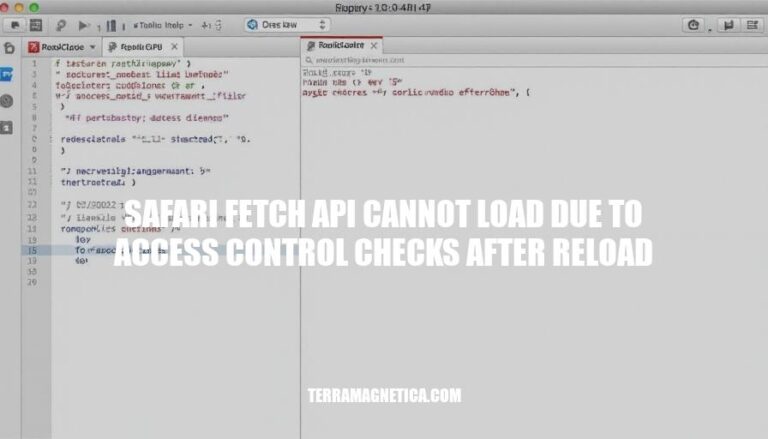


The issue of “Safari Fetch API cannot load due to access control checks after reload” is a significant challenge in web development. This problem arises when Safari’s strict security policies block API requests, often due to improper handling of CORS (Cross-Origin Resource Sharing) headers. This can disrupt the functionality of web applications, leading to failed data fetches and a poor user experience. Addressing this issue is crucial for developers to ensure their applications work seamlessly across all browsers, including Safari.
Access control checks are security measures that ensure only authorized requests can access resources on a server. These checks are part of the Cross-Origin Resource Sharing (CORS) policy, which controls how resources on a web server can be requested from another domain.
When you see the error “Fetch API cannot load due to access control checks” in Safari, it usually means that the server’s response headers are not correctly configured to allow the request from your domain. This often involves the Access-Control-Allow-Origin header not being set properly.
In Safari, this issue can be more pronounced due to its stricter handling of CORS policies, especially after a page reload. This means that even if the initial request succeeds, subsequent requests might fail if the server doesn’t consistently provide the correct CORS headers.
Here are some common causes of the “Safari fetch API cannot load due to access control checks after reload” error, focusing on server-side misconfigurations and CORS policies:
Missing or Incorrect CORS Headers:
Access-Control-Allow-Origin header, or it might be incorrectly configured. This header is crucial for allowing cross-origin requests.Preflight Request Failures:
OPTIONS request to check if the actual request is safe to send. If the server does not handle this preflight request correctly, it can lead to access control errors.HTTPS Issues:
Mismatched Allowed Methods:
POST, PUT) used by the fetch request. The Access-Control-Allow-Methods header should include all methods that the client might use.Incorrect Allowed Headers:
Access-Control-Allow-Headers header, Safari will block the request.Wildcard Restrictions:
*) in the Access-Control-Allow-Origin header can sometimes cause issues, especially if credentials are involved. Safari might enforce stricter checks in such cases.These are some of the typical server-side misconfigurations and CORS policy issues that can lead to this error in Safari.
Sure, here are the detailed troubleshooting steps to resolve the ‘Safari Fetch API cannot load due to access control checks after reload’ error:
Check Server Headers:
Access-Control-Allow-Origin: *
Access-Control-Allow-Methods: GET, POST, PUT, DELETE, OPTIONS
Access-Control-Allow-Headers: Content-Type, Authorization
Configure CORS on the Server:
cors middleware:const express = require('express');
const cors = require('cors');
const app = express();
app.use(cors({
origin: '*',
methods: ['GET', 'POST', 'PUT', 'DELETE', 'OPTIONS'],
allowedHeaders: ['Content-Type', 'Authorization']
}));
app.listen(3000, () => {
console.log('Server running on port 3000');
});
Check Preflight Requests:
Verify HTTPS Configuration:
Debugging in Safari:
Check for Redirects:
Update Safari:
Local Development:
By following these steps, you should be able to resolve the CORS issues in Safari. If the problem persists, it might be helpful to check the server logs for any additional clues.
Here are the best practices to prevent the ‘Safari Fetch API cannot load due to access control checks after reload’ issue:
CORS Headers:
Access-Control-Allow-Origin: * (or specify your domain)Access-Control-Allow-Methods: GET, POST, OPTIONSAccess-Control-Allow-Headers: Content-Type, AuthorizationHTTPS Consistency:
Preflight Requests:
Credentials Mode:
credentials: 'include' in your fetch request and Access-Control-Allow-Credentials: true on the server.Testing:
Server Configuration:
Error Handling:
By following these practices, you can mitigate the access control issues in Safari.
Ensure your server includes the necessary CORS headers in its responses, such as Access-Control-Allow-Origin, Access-Control-Allow-Methods, and Access-Control-Allow-Headers.
Handle preflight OPTIONS requests correctly on the server by responding with the required CORS headers.
Verify that both your site and API endpoints are served over HTTPS to avoid mixed content issues.
Test on actual Safari browsers (both iOS and macOS) to ensure compatibility.
Implement robust error handling in your fetch requests to log and diagnose issues.
Update your server configuration to correctly handle CORS headers and preflight requests.
By addressing these access control issues, you can prevent the ‘Safari Fetch API cannot load due to access control checks after reload’ error and ensure smooth web application performance.